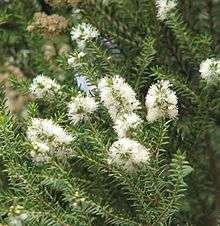Melaleuca lanceolata
| Melaleuca lanceolata | |
|---|---|
 | |
| M. lanceolata in Maranoa Gardens, Victoria | |
| Scientific classification | |
| Kingdom: | Plantae |
| (unranked): | Angiosperms |
| (unranked): | Eudicots |
| (unranked): | Rosids |
| Order: | Myrtales |
| Family: | Myrtaceae |
| Genus: | Melaleuca |
| Species: | M.lanceolata |
| Binomial name | |
| Melaleuca lanceolata Otto | |
| Synonyms | |
|
Melaleuca lanceolata subsp. occidentalis Barlow Melaleuca lanceolata subsp. planifolia Barlow Melaleuca lanceolata subsp. thaeroides Barlow | |
Melaleuca lanceolata commonly known as black paperbark, moonah, Rottnest Island teatree and western black tea tree is a plant in the myrtle family, Myrtaceae and is native to Australia where it occurs in all mainland states (but not the Northern Territory or Tasmania). It is a densely foliaged tree with rough bark and which flowers prolifically in summer.
Description
Melaleuca lanceolata is a large shrub or small tree growing up to 10 metres (30 ft) tall, with rough, dark grey bark on a trunk that is often twisted and bent by the effects of wind. Its branchlets and leaves are covered with soft, silky hairs when young but become glabrous as they mature. The leaves are arranged alternately, 3.1–12.5 millimetres (0.1–0.5 in) long, 0.7–1.9 millimetres (0.03–0.07 in) wide, linear to narrow elliptic in shape with a concave upper surface.[1][2][3]
The flowers are white or cream coloured and arranged in spikes on the ends of branches which continue to grow after flowering, sometimes also in the upper leaf axils. The spikes are up to 60 millimetres (2 in) long, 23 millimetres (0.9 in) in diameter and contain 3 to 12 groups of flowers in threes. The petals are 1.5–3 millimetres (0.06–0.1 in) long and fall off as the flower ages. The stamens are arranged in five bundles around the flowers with 7 to 20 stamens per bundle. The flowering season is mainly in summer but flowers may also appear randomly through the year. The fruits that follow are smooth, almost spherical woody capsules 3–7.5 millimetres (0.1–0.3 in) long that are spaced along the branches.[1][2][3]
Taxonomy and naming
Melaleuca lanceolata was first formally in 1820 described by Christoph Friedrich Otto in Horae Physicae Berolinensis.[4][5] The specific epithet (lanceolata) is from the Latin lancea meaning "a light spear"[6] referring to the shape of the leaves.[1]
Distribution and habitat
Melaleuca lanceolata occurs in Western Australia, South Australia, Victoria, New South Wales and Queensland in mallee or open woodland.[3] In Western Australia it is sometimes a garden escape and has become established in bushland outside of its natural range.[7]
Conservation
This species is classified as "not threatened" by the Western Australian government department of parks and wildlife.[7]
Uses
Horticulture
This is a free-flowering shrub or tree and is useful as an ornamental or maintenance free street tree. It is suitable as a screen or hedge.[8] It is hardy, resistant ot salt spray and suited to most soils but needs full sun to reach its potential.[9]
Agriculture
Moonah makes an excellent windbreak or shelterbelt or shade for stock. It is good for fence posts and the flowers are attractive to wildlife. The pollen has value in beekeeping.[8]
References
- 1 2 3 Brophy, Joseph J.; Craven, Lyndley A.; Doran, John C. (2013). Melaleucas : their botany, essential oils and uses. Canberra: Australian Centre for International Agricultural Research. pp. 211–212. ISBN 9781922137517.
- 1 2 Holliday, Ivan (2004). Melaleucas : a field and garden guide (2nd ed.). Frenchs Forest, N.S.W.: Reed New Holland Publishers. pp. 154–155. ISBN 1876334983.
- 1 2 3 Wilson, Peter G. "Melaleuca lanceolata". Royal Botanic Garden Sydney:PlantNet. Retrieved 12 May 2015.
- ↑ Otto, Christoph Friedrich (1820). "Plantae rariores quae in Horto Regio Berolinensi a mense Ianuario ad ultimum Maium anni 1819 floruere". Horae Physicae Berolinensis: 36. Retrieved 12 May 2015.
- ↑ "Melaleuca lanceolata". APNI. Retrieved 12 May 2015.
- ↑ "lancea". Wiktionary. Retrieved 12 May 2015.
- 1 2 "Melaleuca lanceolata". FloraBase. Department of Environment and Conservation, Government of Western Australia.
- 1 2 "Melaleuca lanceolata". Florabank. Retrieved 12 May 2015.
- ↑ Wrigley, John W.; Fagg, Murray (1983). Australian native plants : a manual for their propagation, cultivation and use in landscaping (2 ed.). Sydney: Collins. ISBN 0002165759.